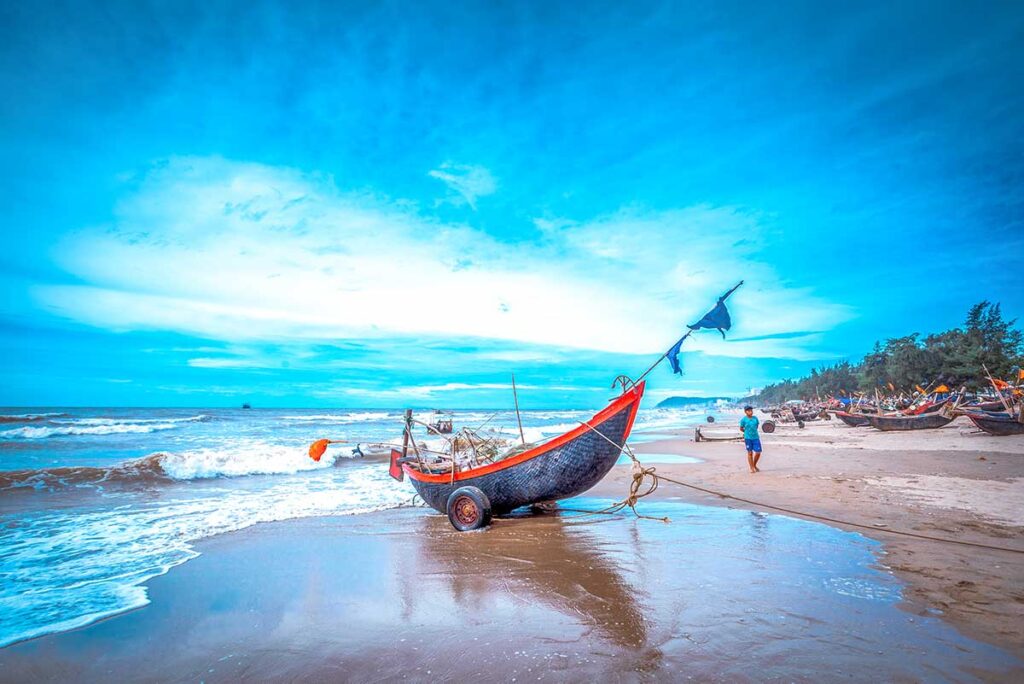About Sam Son Beach
Historical background
Sam Son’s role as a beach destination began during the French colonial period, when it was developed as a summer retreat for mandarins and colonial elites. Originally part of Quang Xuong District, the area was known for its coastal fishing villages and the nearby Truong Le mountain range. Recognizing its scenic potential, the French built villas and basic infrastructure along the coast in the early 20th century. Over time, the beach gained popularity among locals and eventually became one of Vietnam’s most well-known domestic seaside getaways. Today, Sam Son is no longer a small resort town — it was officially designated a city in 2017 and is now a major tourist hub in Thanh Hoa Province.
Scenery and Beach conditions
The beach at Sam Son stretches between 9 and 13 kilometers, depending on how the coastline is measured. It’s a long, mostly flat beach with golden sand and generally mild waves, especially in calmer weather. The landscape is typical for northern Vietnam’s coast — not dramatic, but wide and open.
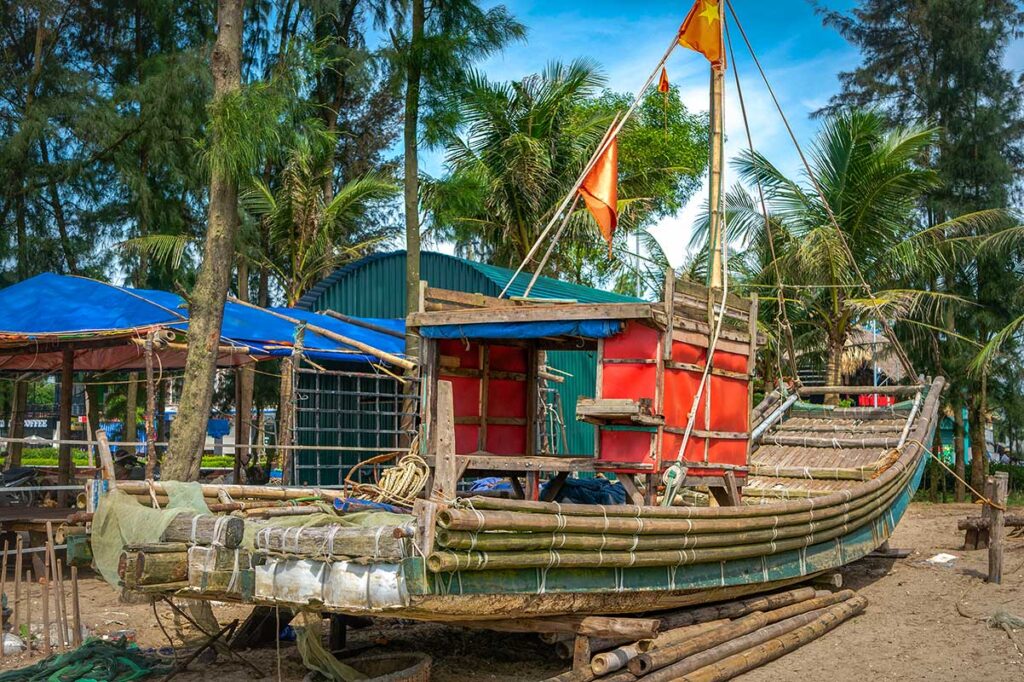
Cleanliness and water quality vary by season. During peak summer months, the beach is regularly cleaned, but off-season or post-storm visits may reveal trash or cloudy water. Compared to southern and central beaches like Da Nang, Nha Trang, or Phu Quoc, Sam Son’s sand is coarser, and the water is less turquoise — something to keep in mind if you’re expecting postcard views.
The beach town
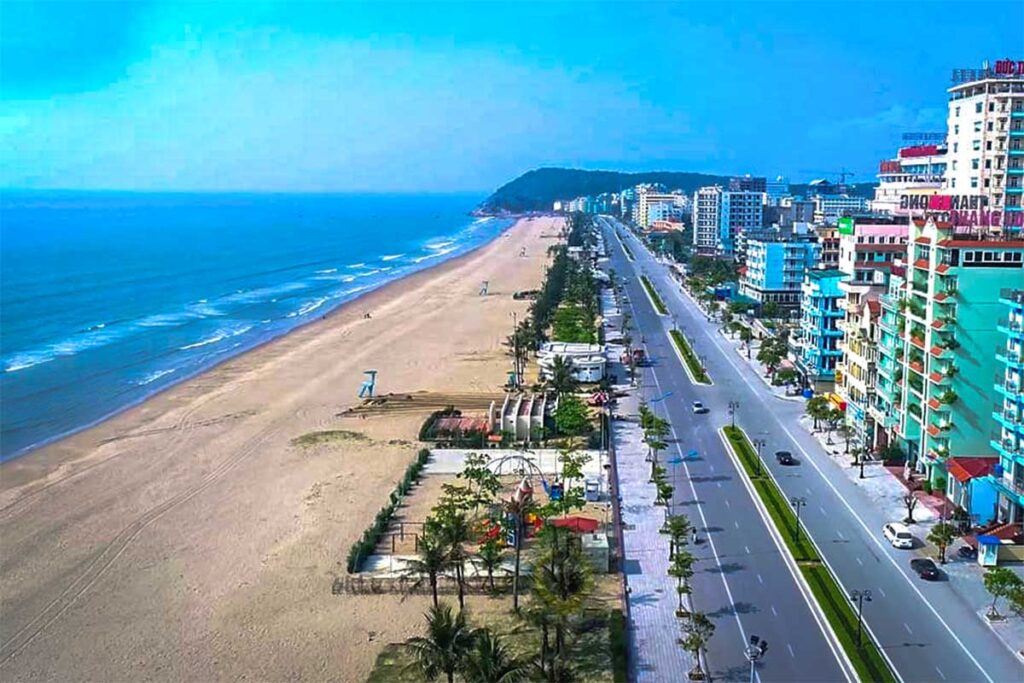
Sam Son City has grown rapidly in recent years, with large-scale hotels, a central beachfront square, and a range of domestic-focused entertainment. During Vietnamese public holidays — especially Reunification Day, Labor Day, and summer weekends — the town is packed with families and organized tour groups.
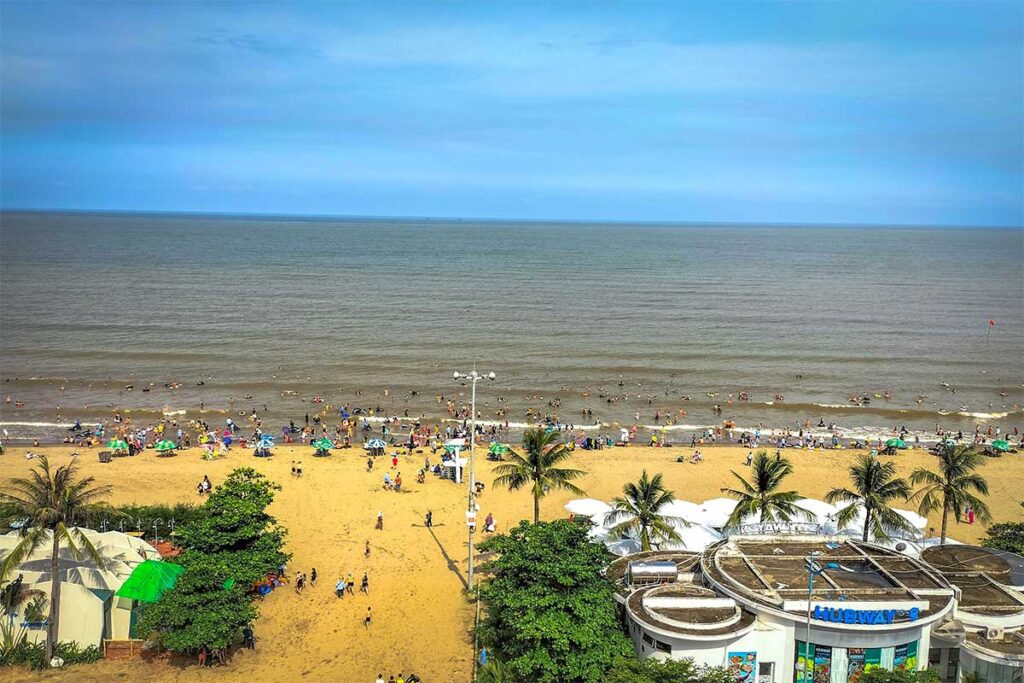
Outside those periods, it can feel unexpectedly quiet, with wide, empty streets and many hotel lobbies sitting idle. Most tourism infrastructure is aimed at Vietnamese visitors, including food, signage, and service style. Foreigners are rare, and English is not widely spoken. That said, the town has everything you’d expect from a local beach destination: a night market, amusement games, seafood restaurants, a walking street, and even a large water park nearby.
Beach areas in Sam Son
Sam Son Beach is often divided into four main sections — labeled A, B, C, and D — each offering a slightly different atmosphere. These zones run along the same coastline, but vary in crowd levels, facilities, and nearby attractions. Understanding the differences can help you choose where to spend your time or book accommodation.
Beach A
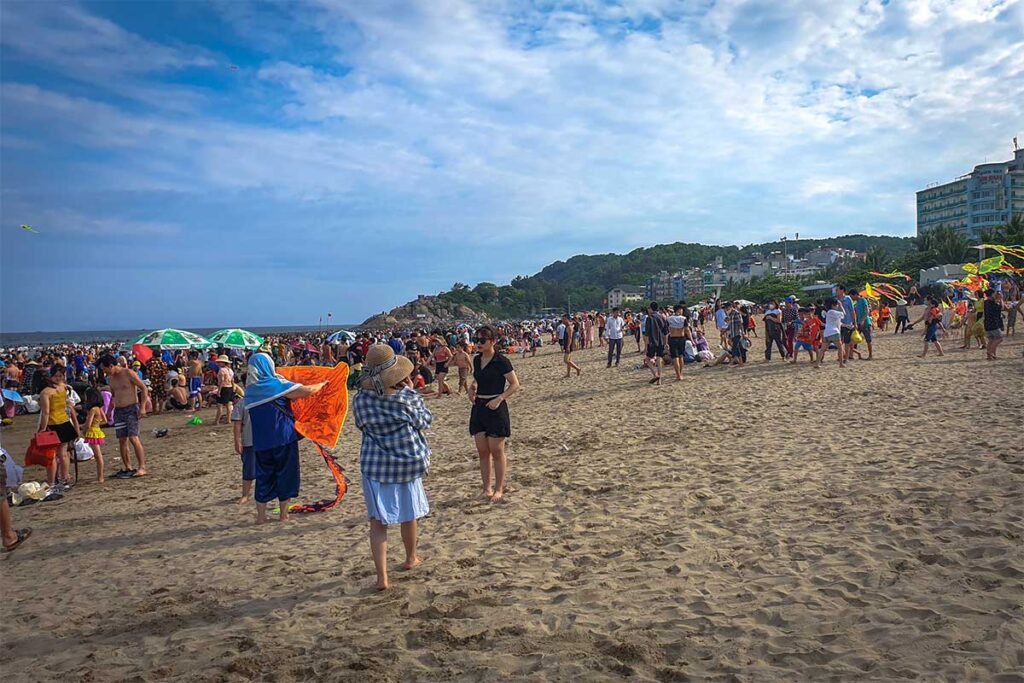
Beach A is the most central and popular area, located near the main square and close to major hotels. It’s the busiest section, especially in summer, with a constant flow of visitors taking photos, playing games, or gathering for group activities. The waves can be stronger here, and the shoreline includes a few rocky spots, so swimming requires a bit more caution. Expect lots of local energy and activity, but not much personal space during peak hours.
Beach B
Just south of Beach A, Beach B offers a more relaxed, family-friendly environment. The waves are milder, and the beach is generally safer for children and older visitors. You’ll find snack stalls and umbrellas available for rent, and it’s conveniently located near many mid-range hotels and guesthouses. This area is a good balance between accessibility and comfort without being too crowded.
Beach C
Beach C is often used for organized recreation like beach volleyball or team-building games. The sand is flat and wide, and the beach tends to be cleaner than the central sections. It’s not as chaotic as Beach A but still lively, especially with corporate or school groups. Several beachfront restaurants and cafés make it easy to take a break without going far.
Beach D
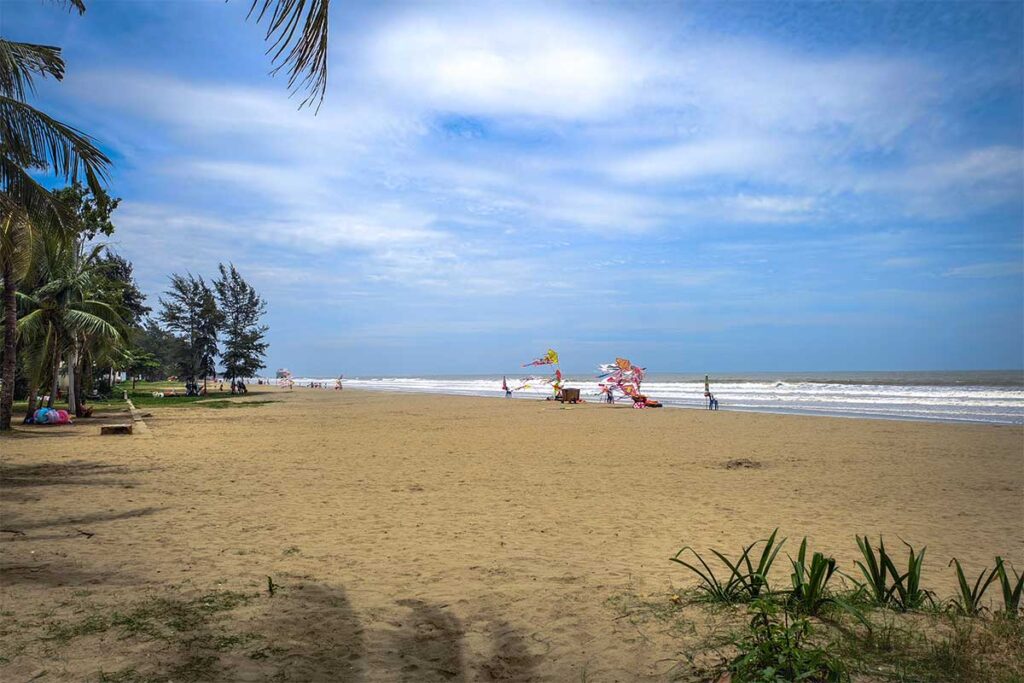
Located closer to the fishing area, Beach D is the quietest of the four zones. It has fewer visitors, limited infrastructure, and a more local feel. You’re more likely to see fishermen and families than tourists. While it’s not the most scenic part of the beach, it offers a more peaceful atmosphere and may appeal to those looking to escape the crowds.
Is Sam Son Beach worth visiting?
If you’re expecting a tropical beach paradise like Phu Quoc or a polished destination like Da Nang, Sam Son is not the place for you. It’s not one of Vietnam’s best beaches in terms of scenery, water quality, or overall travel experience — especially for international visitors.
That said, Sam Son does have its appeal in the right context.
It’s best suited for:
- Short getaways from Hanoi, thanks to its proximity (around 3–4 hours).
- Budget-friendly domestic tourism, especially for families or company outings.
- A stopover on a longer northern Vietnam road trip, where you just want to relax for a few hours by the sea.
It’s not ideal for:
- A full beach holiday focused on swimming, snorkeling, or turquoise water.
- Travelers looking for boutique resorts, international-style service, or refined beachfront dining.
If your expectations are realistic — and your goal is simply a casual break by the sea or to see where locals go on holiday — then Sam Son can still be enjoyable. Go during warm weather, avoid public holidays if possible, and treat it as a cultural curiosity rather than a luxury beach escape.
Best time to visit Sam Son Beach
Timing your visit to Sam Son makes a big difference — not just for the weather, but also for the crowd levels and overall experience. The beach is swimmable for only part of the year, and during peak domestic holiday periods, it can get extremely busy.
Weather patterns
Like the rest of northern Vietnam, Sam Son experiences four seasons, but for travel purposes, it’s easiest to divide the year into two main periods.
- Dry season (November to April): While there’s less rain, this period includes the cool and even chilly winter months. Temperatures can drop below 20°C (68°F), especially from December to February, making swimming uncomfortable or not practical at all.
- Rainy season (May to October): This is when the beach actually comes to life. The weather is hot, the water is warm, and Sam Son becomes a popular destination for locals on holiday. Expect sudden afternoon showers or short storms, but also plenty of sunshine in between. Rain rarely lasts all day.
Best months to visit
The ideal time to enjoy Sam Son Beach is from May to early August, when the weather is consistently warm enough for swimming and beach activities. This is also when seafood restaurants and markets are in full swing.
If you want to avoid the crowds, try to skip major Vietnamese holidays like Reunification Day (April 30 – May 1) and peak weekends in late June and July, when hotels fill up and the beach becomes packed. Weekdays in early summer offer the best balance of good weather and a calmer atmosphere.
How to get to Sam Son Beach
Sam Son Beach is located about 16 kilometers from Thanh Hoa City, the provincial capital. Getting there is relatively easy, especially if you’re starting from Hanoi or passing through on a north–south Vietnam itinerary.
Reaching Thanh Hoa City
From Hanoi, the journey to Thanh Hoa takes about 3 to 4 hours. You can:
- Take a limousine bus: Several operators run comfortable, air-conditioned vans with frequent departures.
- Travel by train: North–South trains stop at Thanh Hoa Railway Station, with soft-seat and sleeper options available.
- Drive or hire a private car: A straightforward route via National Highway 1.
From Ho Chi Minh City or other major southern cities, the fastest way is by flying to Tho Xuan Airport, located around 60 km from Sam Son. From the airport, it’s roughly a 1-hour drive to the coast.
Thanh Hoa is well connected by road and rail, making it a convenient hub even if Sam Son isn’t your final destination.
From Thanh Hoa to Sam Son
Once you’re in Thanh Hoa City, it’s a 16-kilometer journey to the beach.
- Taxi: The most convenient option, taking about 20–30 minutes.
- Motorbike rental: Suitable for confident riders who want more freedom to explore the area.
- Hotel shuttle: Some hotels in Sam Son offer transfers — check in advance.
Local transport in Sam Son includes electric cars (often shared) and cyclo, especially along the beachfront area. These are handy for short distances or getting around in the evening.
Things to See & do in Sam Son
While the beach is the main reason most people visit Sam Son, there are a few cultural and recreational attractions worth checking out — especially if you’re staying overnight or want to explore beyond the sand.
Cultural Trio: Doc Cuoc Temple, Hon Trong Mai & Co Tien Temple
These three sights are all located along the Truong Le Mountain ridge and can be combined into a short walk with sea views, shaded paths, and light uphill sections. They’re not major attractions on their own, but together they make for a pleasant outing — especially if you’re looking to break up beach time with a bit of culture and scenery.
1. Doc Cuoc Temple
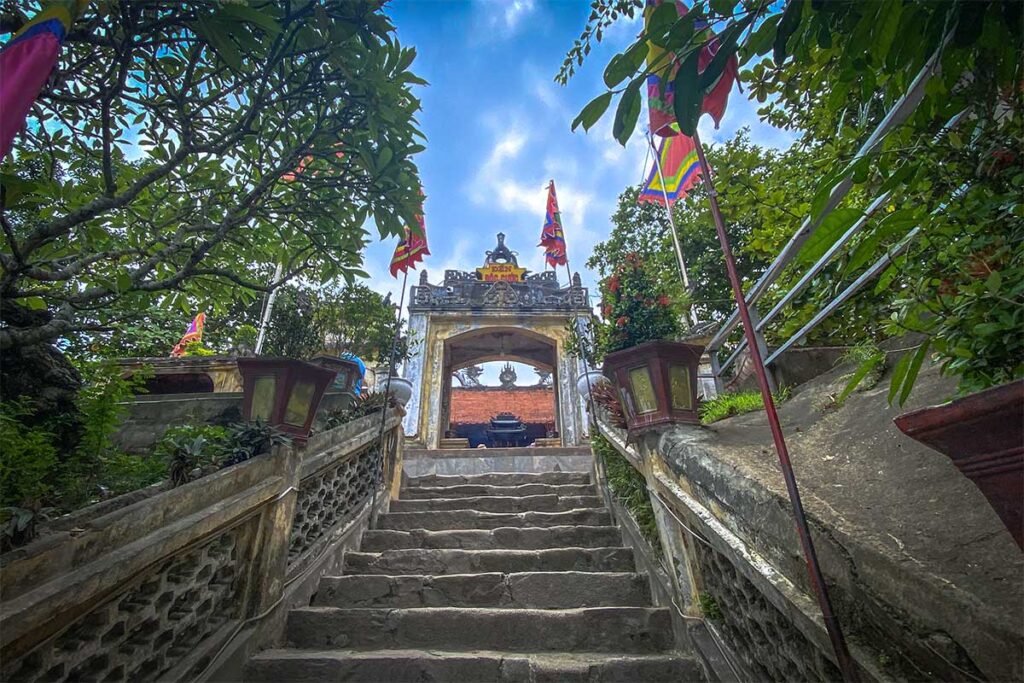
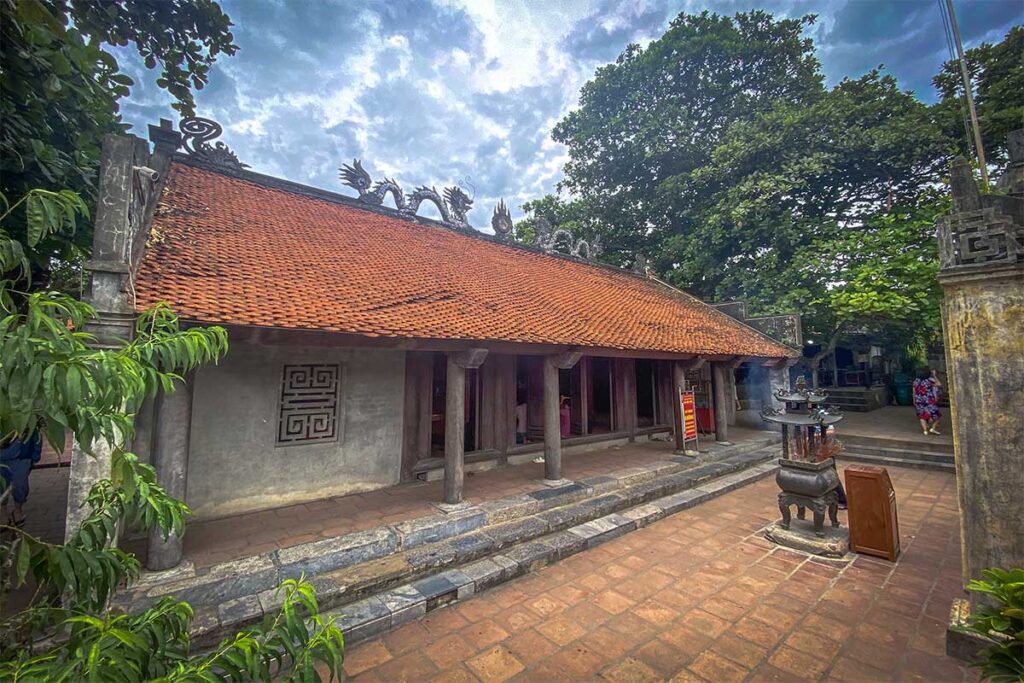
This small seaside temple is perched on the rocks at the base of Truong Le Mountain. It’s linked to the local legend of a one-legged god who split himself in two to protect both the sea and the land.
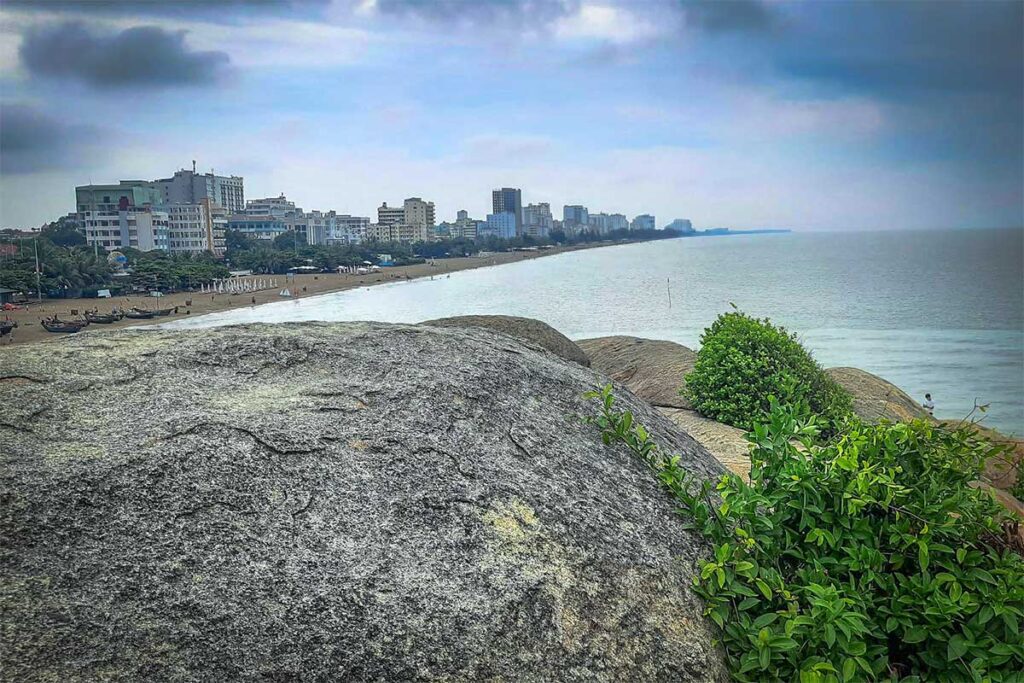
The temple itself is modest but sits in a scenic spot overlooking the ocean, with nearby chairs and vendors offering drinks. A peaceful place to sit and take in the sea breeze.
2. Hon Trong Mai (Rooster & Hen Rocks)
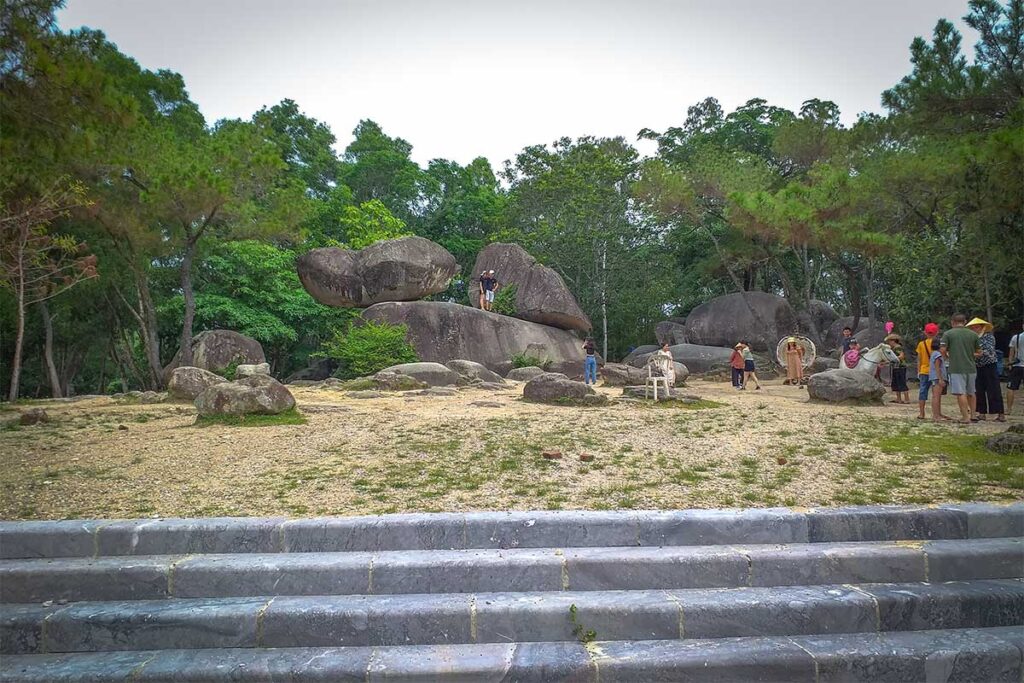
A short walk from Doc Cuoc leads to this unusual rock formation, where two large boulders are said to resemble a rooster and a hen. The legend behind them tells of a fisherman and a fairy who fell in love and turned into birds — then stones — to stay together forever. The rocks are set in a small park area with pine trees and sea views, making it a popular photo stop, especially in the late afternoon.
4. Co Tien Temple (Fairy Temple)
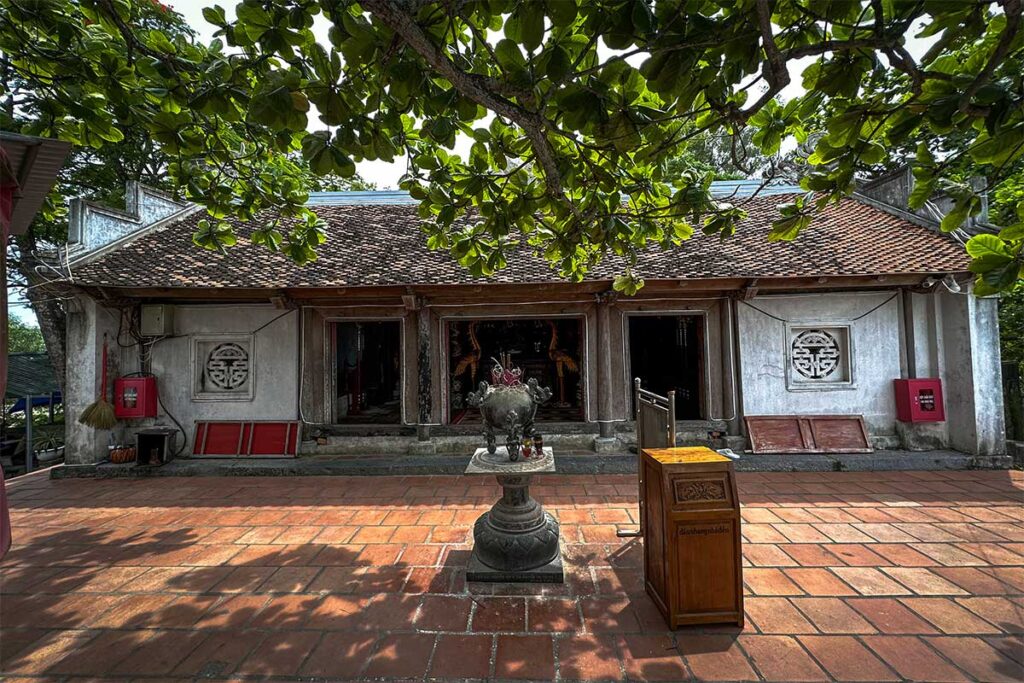
Tucked away on a small hill beyond Hon Trong Mai, Co Tien Temple is quieter and surrounded by forest. According to local lore, it was the home of a healer-turned-fairy who used her powers to help others before vanishing into the mountains. The temple is simple, with a peaceful vibe and a panoramic view of the coast from the back. A short walk but worth it if you’re already visiting the other two.
Other sights and things to do:
5. Sam Son Night Market

Located on Thanh Nien Street, just a few hundred meters from the beach, this night market is one of the town’s liveliest spots after dark. It’s small but packed with local snacks, fresh seafood, dried goods, souvenirs, toys, and clothing. You’ll also find amusement park-style games, sidewalk karaoke, and a mini fairground next door with rides for kids. It can get crowded and stuffy during peak season, but it’s a fun way to spend an evening if you’re staying overnight.
6. Sun World Sam Son Water Park
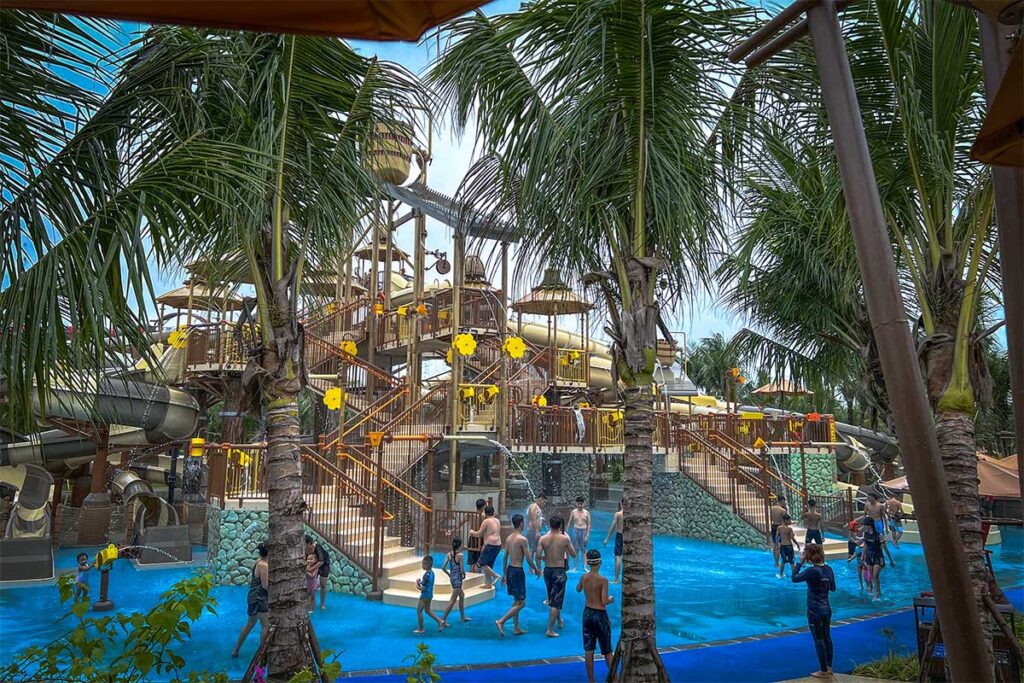
If the sea is too rough or you’re traveling with kids, this water park is a decent alternative. Run by the well-known Sun Group (also behind attractions in Da Nang and Ha Long), it offers pools, slides, and water playgrounds with decent facilities and friendly staff. Entrance is affordable at around 100,000 VND (~$4). It mostly attracts Vietnamese families, and while not a major highlight, it’s a solid backup option on hot or stormy days.
Tips for visiting Sam Son Beach
Sam Son isn’t a difficult destination to visit, but a few simple tips can make your trip more enjoyable — especially if you want to avoid crowds, choose the right hotel, or make the most of your time in Thanh Hoa Province.
Avoiding crowds
The beach gets busiest during Vietnamese school holidays, summer weekends, and public holidays like Reunification Day (April 30 – May 1). If you prefer a quieter experience:
- Visit on weekdays, especially Monday to Thursday.
- Go to the beach in the early morning or mid-afternoon. Locals tend to come out around sunset.
- Avoid peak season weekends between late May and July, when organized groups from Hanoi arrive in large numbers.
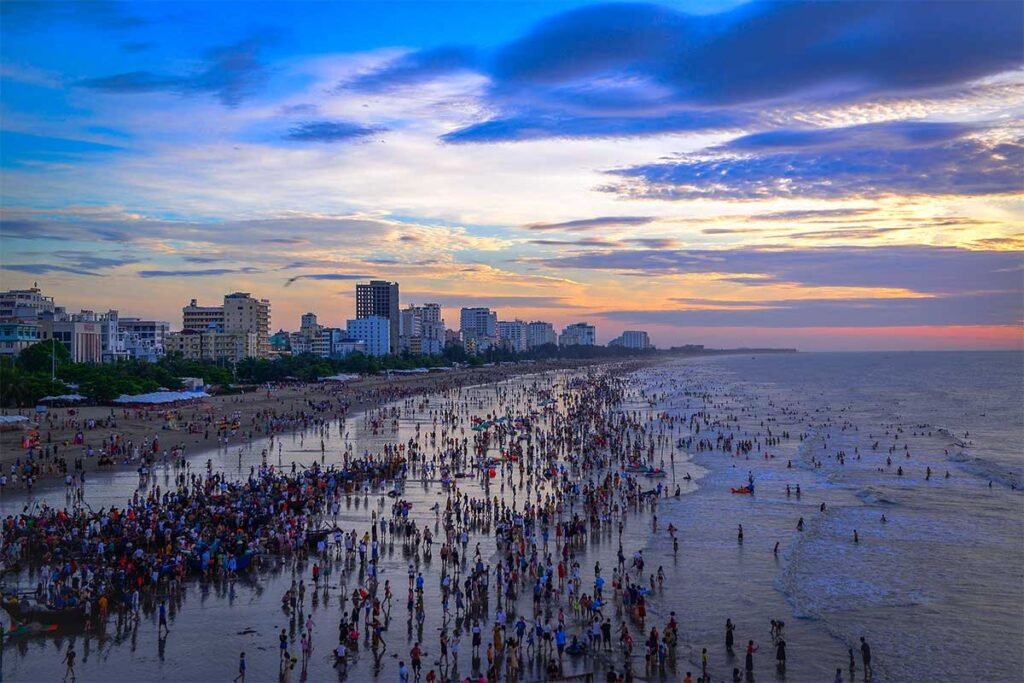
Staying overnight
There’s no shortage of places to stay in Sam Son, with everything from high-rise resorts to local guesthouses.
- Most hotels cater to domestic tourists, which means Vietnamese-style breakfasts, limited English, and local service standards.
- Some beachfront hotels are modern and well-maintained, especially newer developments around the square or main boulevard.
- Others are older and may not meet international expectations, so it’s worth checking recent reviews before booking.
Exploring more of Thanh Hoa
If you’re already in Thanh Hoa Province, there are several more impressive sights that can turn your beach visit into a broader itinerary:
- Ho Dynasty Citadel – A UNESCO World Heritage Site and one of Vietnam’s most historically significant fortresses.
- Pu Luong Nature Reserve – Known for terraced rice fields, minority villages, and off-the-beaten-path trekking.
- Ben En National Park – A quieter destination with lakes, forests, and boat trips — great for nature lovers.
For details on how to visit these places, see our complete list of things to do in Thanh Hoa.
